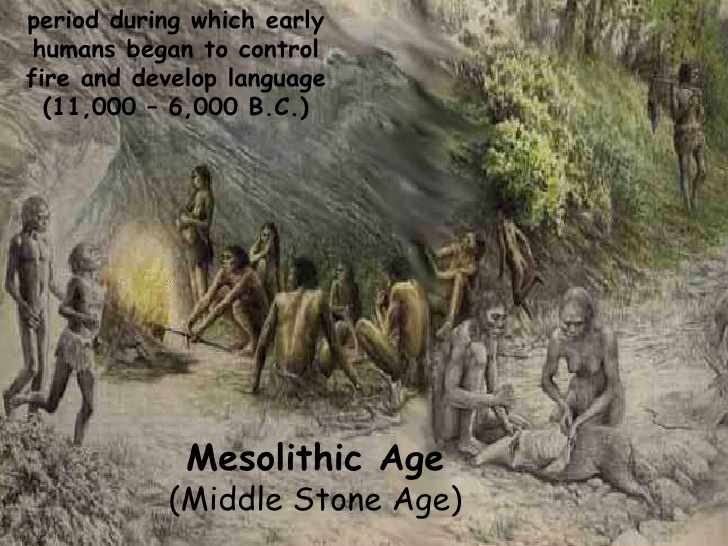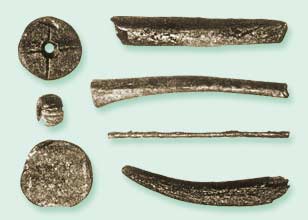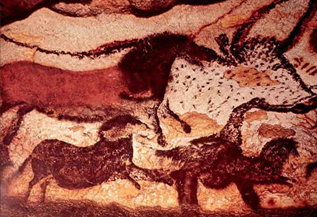- Home
- History of India
- Mesolithic Age
Mesolithic Age
Mesolithic age is
between Paleolithic and Neolithic age. The term Mesolithic is derived from the
Greek word meso means middle and lithic means stone In Mesolithic age,
the climatic conditions – in terms of atmospheric temperature, humidity etc -
improved compared to Paleolithic Age.
With the improvement in weather and climatic conditions, human inhabitation also started to improve in Mesolithic Age. This Age corresponds between Paleolithic Age and Neolithic Age. This period is also referred to as middle Stone Age. Unlike people in Paleolithic Age, people in this age started to live in groups and were working for a permanent settlement. Unlike in Paleolithic Age, people in this age were not hunter-gatherer.
The transition from Paleolithic to Mesolithic is marked by transition from Pleistocene period to Holocene period. The climate became warmer and humid and hence expansion of flora and fauna contributed to increase in rainfall. People of this age started to live in groups nearer to rivers, which led to increase in food production. People started to improve their tools to gather more food.
In early period of Mesolithic age heating, fishing and food gathering was started. Animal bones have been excavated from various Mesolithic sites. Domesticating crops and animals was initially practiced in this age.
Earlier proof of domestication of animals has recently been excavated at Adamgarh in Madhya Pradesh, Bagor in Rajasthan. The first animals that were domesticated are dog, cattle, sheep, goat. Plants cultivated were wheat and barley.

Another important fact is that first human
colonisation took place at the plains of Ganges. There are more than two hundred
Mesolithic sites found in Allahabad, Pratapgarh, Jaunpur, Mirzapur and Varanasi
district of Uttar Pradesh. As people of
Mesolithic age started to settle at one place, this led to the problem of
disposal of dead. There are grounds that have been excavated at Bagor in
Rajasthan, Lanthanum in Gujarat, Bhimbetka in Madhya Pradesh etc.
Tools used by Mesolithic people

Tools used by Mesolithic people:
The tools used by people were small and tiny better finished than Paleolithic people and were called as microliths. These microliths were tiny tools of one to five centimetres length made by blunting one or more side with steep retouch. The main type of tools used were blacked blades obliquely truncated blades with crescent, triangles and trapezes shapes. Some microliths were speared arrowheads, knives, sickles, harpoons and daggers.
These were fitted into grooves in bone wood and reed shafts and joined together
by natural adhesives like gum and resins. Hunting and gathering was given to food productions
hence use of bow and arrow came into existence. The new technology (bow and
arrow) increased the efficiency in the hunting and collection of foods
The main function of the microliths was that it was used as tips and barbs
for arrowhead and spearhead. It was also used for cutting edges of knives, sickles,
dragons and Harpoons. Micro blades were purposely blunt from side so that they
prevent the cutting of haft which would in turn loosen the microliths when it
was in use.
Art in Mesolithic Age

Mesolithic Art
The Mesolithic people were art lovers. This can be understood by the paintings which were mostly in red and white pigments.
The subject matter of these paintings were mostly wild animals and hunting scenes and sometimes gathering plant resources, trapping animals, child birth, dancing etc.
Read more about Indian Art and Architecture
In paintings we can see humans wearing dress and wearing ornaments like head gear, waistband, shell, Ivory etc. The Rock paintings of Mesolithic period are found in Adamgarh, Bhimbetka of Madhya Pradesh and Pratapgarh, Mirzapur of Rajasthan. Some of the other important rock cut painting include-Murhana in Uttar Pradesh, Kupagallu in Karnataka.
Read more on
Mesolithic sites in India
Bagor in Rajasthan, Sarai Nahar Rai in Allahabad, Jharkhand, Chhota Nagpur plateau. In Orissa Mayarbbhanj, Keonjhar, Sundugarh are major Mesolithic sites in India. In south India Godavari bases is rich in microliths.
Microliths Bagor in Rajasthan is the biggest Mesolithic site in India. Bagor in on River kotari were microliths along with animal bones and shells have been excavated. Bones of Bison, Rhinoceros, fish tortoise 11 human burials have been found in Sarai Nahar Rai in Allahabad. The vast distribution of Mesolithic sites in India show that people of this age covered almost whole of India except few places.
Microliths have also been found in some important valleys of River Tapi, Sabramati, Narmada and Mahi. Blades, microliths are also found in Bhimbetka.
The other two important Mesolithic sites in India are Langhnaj in Gujarat and Biharnpur in West Bengal. Bones of wild animals that include mongoose, rhinoceros, blackbuck, wild boar have been excavated from Langhnaj. Seven human skeletons and large number of microliths have also been recovered from the place.
Slowly the
Mesolithic age gave way to Neolithic era or New Stone Age period.
Culture and Lifestyle in Mesolithic age
Mesolithic age was the transitional phase from Paleolithic period. Life of Mesolithic people were much better because of more better tools were used and also started with agriculture and settled at one place mostly near the river side.
Domestication of animals and crops had
begun in Mesolithic period. The first animal that was domesticated was dog,
sheep, goat and the first cultivated were wheat and barley.
Read more about culture of India and Rajasthan
The people of Mesolithic made number of innovation
like bow and arrow for hunting, grinders and hammer stone for grinding food like
roots and tubers of plants.
Read more about ancient India, ancient Indian literature
During the early part of Mesolithic period people used lived in huts with stone paved floors. As the time progressed, people started to make pottery and copper tools with beautiful decorations on it.
Further during the later part of Mesolithic period microliths tools deteriorated and use of Iron tools and pottery increased. In the later part pottery was further improvised and it was mostly wheel made. Pots were thinner, lighter and much stronger.
Due to better climatic conditions, warm temperature
and good rainfall nomadic life and people started to settle at one place.
Burials in Mesolithic age
The dead were buried with knees bent and upper part of the body was
brought forward down. They also believed in life after death and hence
they also buried the dead with food items, jewellery etc. One of the major contributions of
Mesolithic people is farming and living in communities, which necessitated them
to move from hills/ jungles to fertile plains
During the early period of Mesolithic age the dead were buried with body in extended position and left arm on the trunk of the body and head facing towards the west. No goods were offered during this period.
Later as time progressed the
dead was kept in sleeping pose with arms and legs in folding position and head
facing east. During this phase the burials were offered with offering in the
forms of vessels, pottery, ornaments and many more. People believed in life
after death and hence the dead was buried with all food items.
Update on coronavirus in India
Affiliate Disclosure:
If you make any purchase via a link on this site, I may receive a small commission with no added cost to you.



